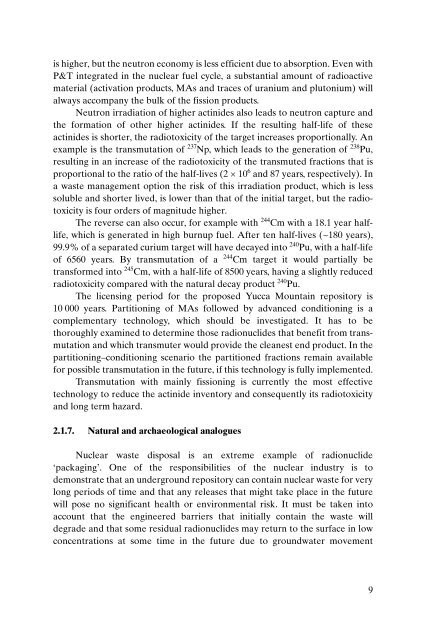TRS435_web
TRS435_web
TRS435_web
Create successful ePaper yourself
Turn your PDF publications into a flip-book with our unique Google optimized e-Paper software.
is higher, but the neutron economy is less efficient due to absorption. Even with<br />
P&T integrated in the nuclear fuel cycle, a substantial amount of radioactive<br />
material (activation products, MAs and traces of uranium and plutonium) will<br />
always accompany the bulk of the fission products.<br />
Neutron irradiation of higher actinides also leads to neutron capture and<br />
the formation of other higher actinides. If the resulting half-life of these<br />
actinides is shorter, the radiotoxicity of the target increases proportionally. An<br />
example is the transmutation of 237 Np, which leads to the generation of 238 Pu,<br />
resulting in an increase of the radiotoxicity of the transmuted fractions that is<br />
proportional to the ratio of the half-lives (2 × 10 6 and 87 years, respectively). In<br />
a waste management option the risk of this irradiation product, which is less<br />
soluble and shorter lived, is lower than that of the initial target, but the radiotoxicity<br />
is four orders of magnitude higher.<br />
The reverse can also occur, for example with 244 Cm with a 18.1 year halflife,<br />
which is generated in high burnup fuel. After ten half-lives (~180 years),<br />
99.9% of a separated curium target will have decayed into 240 Pu, with a half-life<br />
of 6560 years. By transmutation of a 244 Cm target it would partially be<br />
transformed into 245 Cm, with a half-life of 8500 years, having a slightly reduced<br />
radiotoxicity compared with the natural decay product 240 Pu.<br />
The licensing period for the proposed Yucca Mountain repository is<br />
10 000 years. Partitioning of MAs followed by advanced conditioning is a<br />
complementary technology, which should be investigated. It has to be<br />
thoroughly examined to determine those radionuclides that benefit from transmutation<br />
and which transmuter would provide the cleanest end product. In the<br />
partitioning–conditioning scenario the partitioned fractions remain available<br />
for possible transmutation in the future, if this technology is fully implemented.<br />
Transmutation with mainly fissioning is currently the most effective<br />
technology to reduce the actinide inventory and consequently its radiotoxicity<br />
and long term hazard.<br />
2.1.7. Natural and archaeological analogues<br />
Nuclear waste disposal is an extreme example of radionuclide<br />
‘packaging’. One of the responsibilities of the nuclear industry is to<br />
demonstrate that an underground repository can contain nuclear waste for very<br />
long periods of time and that any releases that might take place in the future<br />
will pose no significant health or environmental risk. It must be taken into<br />
account that the engineered barriers that initially contain the waste will<br />
degrade and that some residual radionuclides may return to the surface in low<br />
concentrations at some time in the future due to groundwater movement<br />
9


